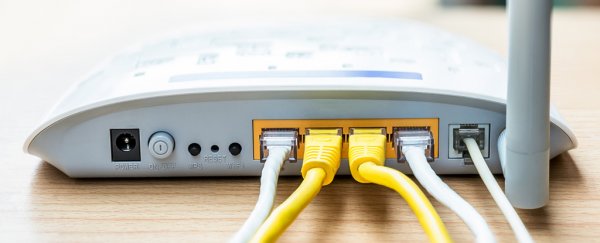It's hard to underestimate how fundamental Wi-Fi is to so many of us these days. Whether we're watching movies on Netflix, streaming music on Spotify, or downloading every science paper on the web for free, that signal in your home is what keeps us connected to the all-knowing, all-seeing Internet. Yeah, there's mobile data too, but it can't compete with home broadband for value when it comes to heavy, ongoing data consumption.
Which is why it's kind of funny that so many of us take for granted where we place our Wi-Fi router in our homes. After all, you're paying for that fast data connection to travel a pretty significant distance to your house or apartment, so it's silly to throw the maximal quality and speed of the signal away because you unwittingly chucked your little digibox in an inopportune location after unboxing it.
It might be common sense to some, but as April Glaser writes at Wired, it's helpful to think of your Wi-Fi router's signal strength in terms of its radius of broadcast. That signal extends out in every direction from the router, meaning you should ideally place the device in a central location in your home. Otherwise, if you store it up one end of your pad, you're really just handing over your quality coverage area to your neighbour, your garden, or the street out front.
Of course, depending on your home and where the phone/data ports in your house are located, that could be easier said than done. The solution then is to consider running some Ethernet cable – which you can buy in some pretty crazy-long lengths – to your router, letting you place it pretty much anywhere in your home you want. (It's worth noting that connecting your PC or Mac to your router directly via Ethernet will also ensure a faster connection than what Wi-Fi allows.)
As Wired points out, the same principle applies to multiple storeys. If you can place the router as close to the vertical middle of your home, that could improve the signal's reach overall.
Another thing to bear in mind is walls. Any solid structure can impede Wi-Fi signals, and while the technology can impressively permeate things like walls some of the time, they'll still have an impact on the signal.
Because of this, place your router in as open a location as possible, away from brick or concrete walls if you can – and similarly avoid the floor, which will block in part any Wi-Fi waves directed downwards.
As we've mentioned before, other electronics in your home can interfere with the frequency of your Wi-Fi too, so try to keep your router away from things like TVs, microwaves, cordless phones, and any other kinds of devices that broadcast wireless signals as part of their regular operation.
Don't forget about your router's antenna either. Not all router models include an external antenna you can manipulate, but if yours does have one – by all means, manipulate it! Seriously, the angle and direction of your router's antenna will have an impact on the way it broadcasts radio waves, and it could make a noticeable difference in your home.
Which brings us to our last point. When you're playing around with Wi-Fi, it's a good idea to bring a little scientific measurement into the equation. There are plenty of apps and websites that help you measure the download and upload speed of the device you're currently using, so when you're trying a new router placement or configuration, take the time to prove to yourself that your new setup is better than your old one – for at least the locations in your house where you'll most often be needing good data speeds. Good luck!
